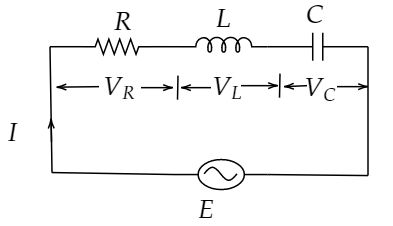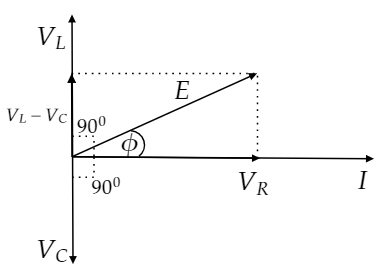Question
Question: What is the phase angle in a series RLC circuit at resonance? A) \({180^0}\) B) \({90^0}\) C) ...
What is the phase angle in a series RLC circuit at resonance?
A) 1800
B) 900
C) 00
D) −900
E) None of the above
Solution
A series RLC is an AC circuit that is said to be in electrical resonance when the circuit power factor is unity i.e., XL=XC. Where XL and XC are inductive reactance and capacitive reactance respectively.
The phase angle in a RLC circuit is given by ϕ=tan−1(RXL−XC). Where R is the resistance.
Complete step by step answer:
Let’s draw an AC circuit containing resistor, inductor and capacitor in series. E and I are the e.m.f. and current in the circuit respectively.

The voltage across resistor (R), VR=IR
VR is in phase with I.
The voltage across inductor (L), VL=IXL
VL leads I by 900.
The voltage across capacitor (C), VC=IXC
VC lags I by 900.
Consider VL>VC. Now draw the phasor diagram.

The resultant voltage in the phasor diagram is the applied voltage and it is given by
E=VR2+(VL−VC)2
Or E=(IR)2+(IXL−IXC)2
Or I=R2+(XL−XC)2E
The quantity Z=R2+(XL−XC)2 is called impedance of the circuit.
The angle ϕ in the above phasor diagram is known as phase angle in the circuit.
tanϕ=VRVL−VC
Or tanϕ=RXL−XC
Or ⇒ϕ=tan−1(RXL−XC)
At resonance, the impedance of the circuit is minimum and is equal to the resistance of the circuit.
i.e., Z=R
Or R2+(XL−XC)2=R
Further simplify
⇒XL=XC
Now at resonance, phase angle ϕ=tan−1(0)
Or ϕ=00
Hence, the correct option is (C) 00.
Note: Alternative method for solving the problem:
When the RLC series AC circuit is at resonance, the average power in the circuit is maximum.
P=ErmsIrmscosϕ.
Where Erms and Irms are the rms values of voltage and current in the circuit.
coϕ is called the power factor of the circuit.
At resonance, P=ErmsIrms
Therefore, cosϕ=1
Or ϕ=00
